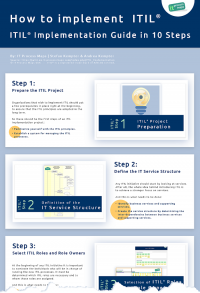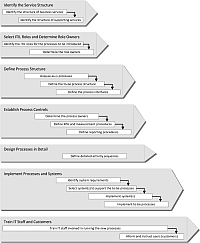ITIL Implementation: Difference between revisions
No edit summary |
|||
| Line 1: | Line 1: | ||
< | <itpmch><title>ITIL Implementation | IT Process Wiki</title> | ||
<meta name="keywords" content="itil implementation, implementation itil, itil project phases" /> | |||
<meta name="description" content="ITIL implementation projects are characterized by a typical course of action, independent of the size of the company and its core business." /> | |||
</itpmch> | |||
<imagemap> | <imagemap> | ||
Image:ITIL-Wiki-de-es.jpg|DE - ES - ITIL Implementation - Implement ITIL|100px | Image:ITIL-Wiki-de-es.jpg|DE - ES - ITIL Implementation - Implement ITIL|100px | ||
| Line 8: | Line 11: | ||
<br style="clear:both;"/> | <br style="clear:both;"/> | ||
<p> </p> | |||
[[image:Itil-implementation.png|thumb|200px|right|alt=ITIL Implementation in 10 Steps|Fig. 1:<br /> [[ITIL Implementation/_Infographic|Infographic: "ITIL Implementation" - 10 Steps to successfully implement ITIL.]]]] | [[image:Itil-implementation.png|thumb|200px|right|alt=ITIL Implementation in 10 Steps|Fig. 1:<br /> [[ITIL Implementation/_Infographic|Infographic: "ITIL Implementation" - 10 Steps to successfully implement ITIL.]]]] | ||
ITIL implementation projects are characterized by a typical course of action, independent of the size of the company and its core business. This made it feasible to devise a time-tested project blueprint which can serve as a guideline for a wide range of ITIL initiatives. | ITIL implementation projects are characterized by a typical course of action, independent of the size of the company and its core business. This made it feasible to devise a time-tested project blueprint which can serve as a guideline for a wide range of ITIL initiatives. | ||
| Line 14: | Line 18: | ||
<p> </p> | <p> </p> | ||
== ITIL Implementation in 10 Steps == | ==ITIL Implementation in 10 Steps== | ||
An ITIL implementation project is structured in several phases, which each build upon the results of the previous project steps (see the [[ITIL Implementation# | An ITIL implementation project is structured in several phases, which each build upon the results of the previous project steps (see the [[ITIL Implementation#ITIL_Implementation_Project_Course|Overview of the ITIL Implementation Project Steps]]). | ||
The work effort during the progress of an IT Service Management project is usually not distributed equally over the project course. The project begins with the definition of the processes and the organizational framework. In this case, it is possible to provide very concrete instructions, as this project phase allows itself to be extensively standardized. | The work effort during the progress of an IT Service Management project is usually not distributed equally over the project course. The project begins with the definition of the processes and the organizational framework. In this case, it is possible to provide very concrete instructions, as this project phase allows itself to be extensively standardized. | ||
| Line 22: | Line 26: | ||
A larger work is usually involved for the IT organization during the actual implementation of the processes and systems. | A larger work is usually involved for the IT organization during the actual implementation of the processes and systems. | ||
However, if the correct steps have already been taken during the conceptual phase of the ITIL project, it is decidedly easier to assign the available human and financial resources in an economical way. Contrary to this, if no well-designed conceptual phase takes place at the outset of the project, there is the risk of taking measures during the process and system implementation, which would prove expensive and disadvantageous for the business in the long-term; in this case, a reversion is hardly possible without further losses. | However, if the [[#ITIL Implementation Project Course|correct steps]] have already been taken during the conceptual phase of the ITIL project, it is decidedly easier to assign the available human and financial resources in an economical way. Contrary to this, if no well-designed conceptual phase takes place at the outset of the project, there is the risk of taking measures during the process and system implementation, which would prove expensive and disadvantageous for the business in the long-term; in this case, a reversion is hardly possible without further losses. | ||
<p> </p> | <p> </p> | ||
==ITIL Implementation Project Course== | |||
<imagemap> | <imagemap> | ||
| Line 31: | Line 37: | ||
desc bottom-left | desc bottom-left | ||
</imagemap> | </imagemap> | ||
*[[ITIL Implementation - Project Preparation|Step 1: ITIL Project Preparation]] | *[[ITIL Implementation - Project Preparation|Step 1: ITIL Project Preparation]] | ||
*[[ITIL Implementation - IT Service Structure|Step 2: Definition of the IT Service Structure]] | *[[ITIL Implementation - IT Service Structure|Step 2: Definition of the IT Service Structure]] | ||
| Line 50: | Line 54: | ||
<br style="clear:both;"/> | <br style="clear:both;"/> | ||
==Implementing ITIL as a Way to get ready for ISO 20000== | |||
Our ITIL implementation guideline is designed to ensure that, after completion of the project, the [[ISO 20000#Central Requirements from ISO 20000|central requirements of the ISO 20000 standard]] are fulfilled. | Our ITIL implementation guideline is designed to ensure that, after completion of the project, the [[ISO 20000#Central Requirements from ISO 20000|central requirements of the ISO 20000 standard]] are fulfilled. | ||
| Line 60: | Line 64: | ||
<p> </p> | <p> </p> | ||
== ITIL | ==Implementing ITIL with with Process Templates== | ||
*[[ITIL Implementation with Process Templates|ITIL Implementation with Process Templates (ITIL Process Models)]] | *[[ITIL Implementation with Process Templates|ITIL Implementation with Process Templates (ITIL Process Models)]] | ||
*[[Switching from ITIL V2 to ITIL V3|Switching from ITIL V2 to ITIL V3 / ITIL 2011]] | *[[Switching from ITIL V2 to ITIL V3|Switching from ITIL V2 to ITIL V3 / ITIL 2011]] | ||
| Line 66: | Line 70: | ||
<p> </p> | <p> </p> | ||
== More on ITIL Implementation Projects == | ==More on ITIL Implementation Projects== | ||
*[[ITIL for Small and Medium-Sized Businesses]] | *[[ITIL for Small and Medium-Sized Businesses]] | ||
*[[ITIL Introduction in Stages]] | *[[ITIL Introduction in Stages]] | ||
| Line 73: | Line 77: | ||
<p> </p> | <p> </p> | ||
<html><a rel="author" href="https://plus.google.com/111925560448291102517"><img style="margin:0px 0px 0px 0px;" src="/skins/Vector/images/itpm/bookmarking/gplus.png" width="16" height="16" title="By: Stefan Kempter | Profile on Google+" alt="Author: Stefan Kempter, IT Process Maps GbR" /></a></html> | ==[ Infobox ]== | ||
<html><table class="wikitable"> | |||
<tr> | |||
<td>Link to this page:</td> | |||
<td><a itemprop="url" href="https://wiki.en.it-processmaps.com/index.php/ITIL_Implementation">https://wiki.en.it-processmaps.com/index.php/ITIL_Implementation</a></td> | |||
</tr> | |||
<tr> | |||
<td>Languages:</td> | |||
<td><span itemprop="inLanguage" content="en">English</span> | <span><a itemprop="citation" class="external text" href="https://wiki.de.it-processmaps.com/index.php/ITIL-Implementierung">Deutsch</a></span> | <span><a itemprop="citation" class="external text" href="https://wiki.es.it-processmaps.com/index.php/Implementaci%C3%B3n_de_ITIL">español</a></span></td> | |||
</tr> | |||
<tr> | |||
<td>Image:</td> | |||
<td style="vertical-align:top"><a itemprop="primaryImageOfPage" href="https://wiki.en.it-processmaps.com/images/1/15/Itil-implementation.png" title="How to implement ITIL? - ITIL Implementation Guide in 10 Steps">How to implement ITIL (.JPG)</a></td> | |||
</tr> | |||
<tr> | |||
<td>Author:</td> | |||
<td><span itemprop="author">Stefan Kempter</span>, <span itemprop="creator copyrightHolder publisher">IT Process Maps</span> <a rel="author" href="https://plus.google.com/111925560448291102517"><img style="margin:0px 0px 0px 0px;" src="/skins/Vector/images/itpm/bookmarking/gplus.png" width="16" height="16" title="By: Stefan Kempter | Profile on Google+" alt="Author: Stefan Kempter, IT Process Maps GbR" /></a></td> | |||
</tr> | |||
</table></html> | |||
<p> </p> | |||
<!-- This page is assigned to the following categories: --> | <!-- This page is assigned to the following categories: --> | ||
[[Category:ITIL implementation|!]][[Category:ITIL 2011]] | [[Category:ITIL implementation|!]][[Category:ITIL 2011]] | ||
<!-- --- --> | <!-- --- --> | ||
Revision as of 13:41, 11 September 2014


Infographic: "ITIL Implementation" - 10 Steps to successfully implement ITIL.
ITIL implementation projects are characterized by a typical course of action, independent of the size of the company and its core business. This made it feasible to devise a time-tested project blueprint which can serve as a guideline for a wide range of ITIL initiatives.
ITIL Implementation in 10 Steps
An ITIL implementation project is structured in several phases, which each build upon the results of the previous project steps (see the Overview of the ITIL Implementation Project Steps).
The work effort during the progress of an IT Service Management project is usually not distributed equally over the project course. The project begins with the definition of the processes and the organizational framework. In this case, it is possible to provide very concrete instructions, as this project phase allows itself to be extensively standardized.
A larger work is usually involved for the IT organization during the actual implementation of the processes and systems.
However, if the correct steps have already been taken during the conceptual phase of the ITIL project, it is decidedly easier to assign the available human and financial resources in an economical way. Contrary to this, if no well-designed conceptual phase takes place at the outset of the project, there is the risk of taking measures during the process and system implementation, which would prove expensive and disadvantageous for the business in the long-term; in this case, a reversion is hardly possible without further losses.
ITIL Implementation Project Course

- Step 1: ITIL Project Preparation
- Step 2: Definition of the IT Service Structure
- Step 3: Selection of ITIL Roles and Role Owners
- Step 4: Analysis of As-Is Processes: ITIL-Assessment
- Step 5: Definition of the To-Be Process Structure
- Step 6: Definition of Process Interfaces
- Step 7: Establishing Process Control
- Step 8: Designing the Processes in Detail
- Step 9: Selection and Implementation of Application Systems
- Step 10: ITIL Process Implementation and Training
- At a glance: Infographic "ITIL Implemention"
Implementing ITIL as a Way to get ready for ISO 20000
Our ITIL implementation guideline is designed to ensure that, after completion of the project, the central requirements of the ISO 20000 standard are fulfilled.
Although there is no formal relationship between ISO 20000 and ITIL, ISO 20000 clearly draws on ITIL principles. The ISO/IEC 20000:2005 version of the standard, published in 2005, was designed to be aligned with ITIL V2 (the then current version of ITIL). ITIL V3, in turn, was published in 2007; part of the motivation behind creating ITIL V3 was to achieve even better alignment with ISO 20000.
Accordingly, although this is not explicitly stated in the standard, preparing an IT organization for ISO 20000 certification typically involves introducing ITIL principles.
Implementing ITIL with with Process Templates
- ITIL Implementation with Process Templates (ITIL Process Models)
- Switching from ITIL V2 to ITIL V3 / ITIL 2011
More on ITIL Implementation Projects
- ITIL for Small and Medium-Sized Businesses
- ITIL Introduction in Stages
- Key Factors for ITIL Implementations
[ Infobox ]
| Link to this page: | https://wiki.en.it-processmaps.com/index.php/ITIL_Implementation |
| Languages: | English | Deutsch | español |
| Image: | How to implement ITIL (.JPG) |
| Author: | Stefan Kempter, IT Process Maps |






